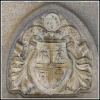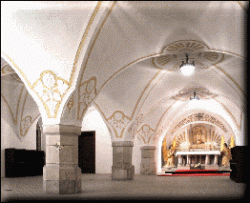World War One and its consequences
 Abbot Bruno Pammer was (1902 – 1924) was the penultimate abbot of the Monastery Vyšší Brod. The time of his rule covered World War One, the revolution after that and the foundation of the first Czechoslovak Republic. Abbot Bruno Pammer was politically active within the German Christian and social movement. This made him less than agreeable to the new government. He paid special attention to gaining new novices, which was also the main concern of his successor. This had the effect that before World War Two the monastery had the highest number of members in its history. During the rule of Abbot Bruno Pammer electric light was introduced into the monastery (1904) from a power plant that was established on the monastery’s grounds. He also arranged the construction of a local electric railway, operated and financed mainly by the monastery, which linked the area to the national railway network. Abbot Tecelin Jaksch (1925 – 1954, after 1949 Administrator of the Rein Monastery) was the 43rd abbot of Vyšší Brod. The greatest service of this sorely tried abbot was, apart from his concern for gaining new novices, the favorable completion of Vyšší Brod's land reform. Originally, most of the monastery’s property was subject to confiscation by the state. The monastery lost only part of its property, especially some farmsteads, which were allocated or rented to Czech owners. Another service of this abbot was the revival of having lay brothers.
Abbot Bruno Pammer was (1902 – 1924) was the penultimate abbot of the Monastery Vyšší Brod. The time of his rule covered World War One, the revolution after that and the foundation of the first Czechoslovak Republic. Abbot Bruno Pammer was politically active within the German Christian and social movement. This made him less than agreeable to the new government. He paid special attention to gaining new novices, which was also the main concern of his successor. This had the effect that before World War Two the monastery had the highest number of members in its history. During the rule of Abbot Bruno Pammer electric light was introduced into the monastery (1904) from a power plant that was established on the monastery’s grounds. He also arranged the construction of a local electric railway, operated and financed mainly by the monastery, which linked the area to the national railway network. Abbot Tecelin Jaksch (1925 – 1954, after 1949 Administrator of the Rein Monastery) was the 43rd abbot of Vyšší Brod. The greatest service of this sorely tried abbot was, apart from his concern for gaining new novices, the favorable completion of Vyšší Brod's land reform. Originally, most of the monastery’s property was subject to confiscation by the state. The monastery lost only part of its property, especially some farmsteads, which were allocated or rented to Czech owners. Another service of this abbot was the revival of having lay brothers.  They had nearly died out, but nine before World War Two they reached number of nine. Abbot Tecelin organized brisk construction activities both in the monastery (renovating the monastery church) and in the parishes (churches and parish buildings). Thus he gave work and wage to many at a time of the world economic crisis, an example of why we should be especially proud of the monaster's charity and social activity. As a result, the local population felt a bond with the monastery. Statistically, the local population made up the smallest number of members in the National Socialist Party during the Third Reich. Abbot Tecelin also had a plan to wake the Monastery of Zlatá Koruna to new life. This magnificent monastery church was in good condition as a parish church, but the monastery buildings had deteriorated badly. Renovation work was done in the monastery before and even during World War Two, so that an early resettling of the monastery seemed possible.
They had nearly died out, but nine before World War Two they reached number of nine. Abbot Tecelin organized brisk construction activities both in the monastery (renovating the monastery church) and in the parishes (churches and parish buildings). Thus he gave work and wage to many at a time of the world economic crisis, an example of why we should be especially proud of the monaster's charity and social activity. As a result, the local population felt a bond with the monastery. Statistically, the local population made up the smallest number of members in the National Socialist Party during the Third Reich. Abbot Tecelin also had a plan to wake the Monastery of Zlatá Koruna to new life. This magnificent monastery church was in good condition as a parish church, but the monastery buildings had deteriorated badly. Renovation work was done in the monastery before and even during World War Two, so that an early resettling of the monastery seemed possible.
